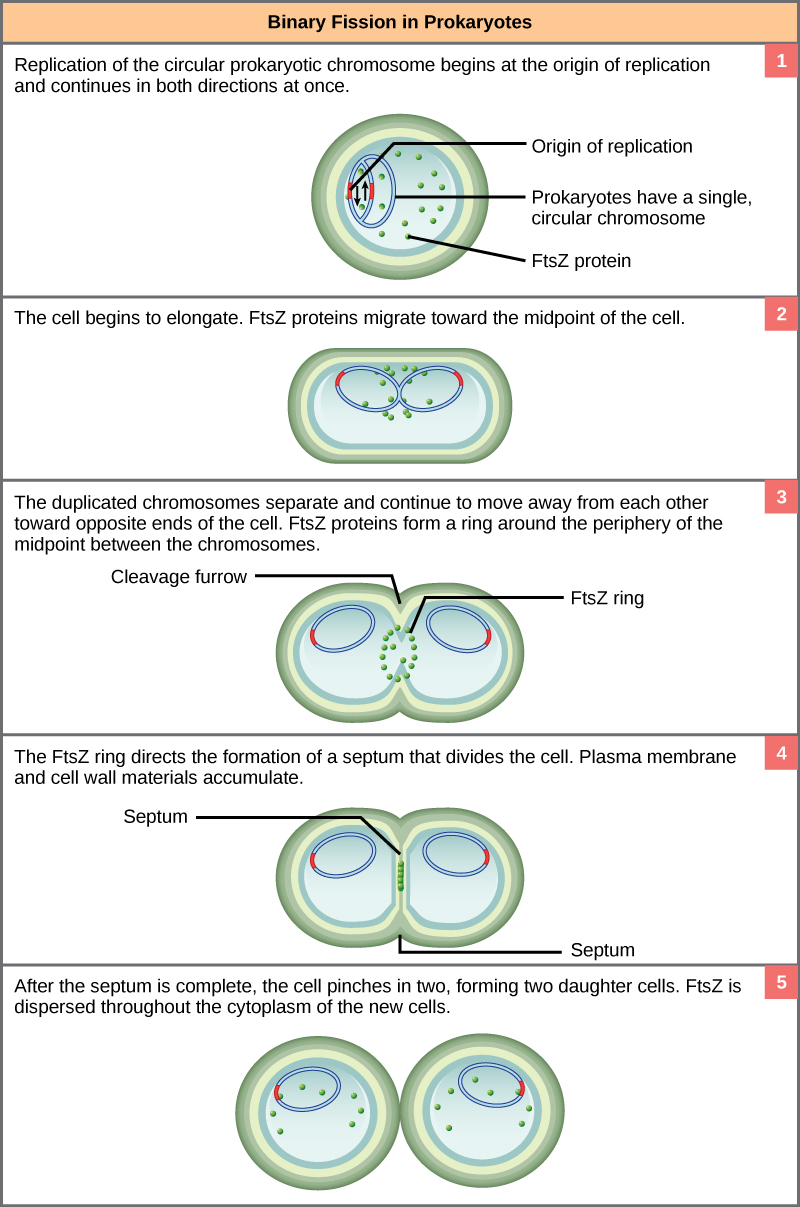| << Chapter < Page | Chapter >> Page > |
Prokaryotes such as bacteria propagate by binary fission. For unicellular organisms, cell division is the only method to produce new individuals. In both prokaryotic and eukaryotic cells, the outcome of cell reproduction is a pair of daughter cells that are genetically identical to the parent cell. In unicellular organisms, daughter cells are individuals.
To achieve the outcome of identical daughter cells, some steps are essential. The genomic DNA must be replicated and then allocated into the daughter cells; the cytoplasmic contents must also be divided to give both new cells the machinery to sustain life. In bacterial cells, the genome consists of a single, circular DNA chromosome; therefore, the process of cell division is simplified. Mitosis is unnecessary because there is no nucleus or multiple chromosomes. This type of cell division is called binary fission.
The cell division process of prokaryotes, called binary fission , is a less complicated and much quicker process than cell division in eukaryotes. Because of the speed of bacterial cell division, populations of bacteria can grow very rapidly. The single, circular DNA chromosome of bacteria is not enclosed in a nucleus, but instead occupies a specific location, the nucleoid, within the cell. As in eukaryotes, the DNA of the nucleoid is associated with proteins that aid in packaging the molecule into a compact size. The packing proteins of bacteria are, however, related to some of the proteins involved in the chromosome compaction of eukaryotes.
The starting point of replication, the origin , is close to the binding site of the chromosome to the plasma membrane ( [link] ). Replication of the DNA is bidirectional—moving away from the origin on both strands of the DNA loop simultaneously. As the new double strands are formed, each origin point moves away from the cell-wall attachment toward opposite ends of the cell. As the cell elongates, the growing membrane aids in the transport of the chromosomes. After the chromosomes have cleared the midpoint of the elongated cell, cytoplasmic separation begins. A septum is formed between the nucleoids from the periphery toward the center of the cell. When the new cell walls are in place, the daughter cells separate.

FtsZ and tubulin are an example of homology, structures derived from the same evolutionary origins. In this example, FtsZ is presumed to be similar to the ancestor protein to both the modern FtsZ and tubulin. While both proteins are found in extant organisms, tubulin function has evolved and diversified tremendously since the evolution from its FtsZ-like prokaryotic origin. A survey of cell-division machinery in present-day unicellular eukaryotes reveals crucial intermediary steps to the complex mitotic machinery of multicellular eukaryotes ( [link] ).
| Mitotic Spindle Evolution | |||
|---|---|---|---|
| Structure of genetic material | Division of nuclear material | Separation of daughter cells | |
| Prokaryotes | There is no nucleus. The single, circular chromosome exists in a region of cytoplasm called the nucleoid. | Occurs through binary fission. As the chromosome is replicated, the two copies move to opposite ends of the cell by an unknown mechanism. | FtsZ proteins assemble into a ring that pinches the cell in two. |
| Some protists | Linear chromosomes exist in the nucleus. | Chromosomes attach to the nuclear envelope, which remains intact. The mitotic spindle passes through the envelope and elongates the cell. No centrioles exist. | Microfilaments form a cleavage furrow that pinches the cell in two. |
| Other protists | Linear chromosomes exist in the nucleus. | A mitotic spindle forms from the centrioles and passes through the nuclear membrane, which remains intact. Chromosomes attach to the mitotic spindle. The mitotic spindle separates the chromosomes and elongates the cell. | Microfilaments form a cleavage furrow that pinches the cell in two. |
| Animal cells | Linear chromosomes exist in the nucleus. | A mitotic spindle forms from the centrioles. The nuclear envelope dissolves. Chromosomes attach to the mitotic spindle, which separates them and elongates the cell. | Microfilaments form a cleavage furrow that pinches the cell in two. |
In both prokaryotic and eukaryotic cell division, the genomic DNA is replicated and each copy is allocated into a daughter cell. The cytoplasmic contents are also divided evenly to the new cells. However, there are many differences between prokaryotic and eukaryotic cell division. Bacteria have a single, circular DNA chromosome and no nucleus. Therefore, mitosis is not necessary in bacterial cell division. Bacterial cytokinesis is directed by a ring composed of a protein called FtsZ. Ingrowth of membrane and cell-wall material from the periphery of the cells results in a septum that eventually forms the separate cell walls of the daughter cells.

Notification Switch
Would you like to follow the 'Concepts of biology' conversation and receive update notifications?